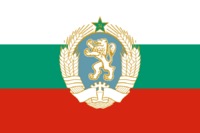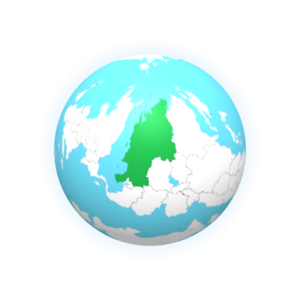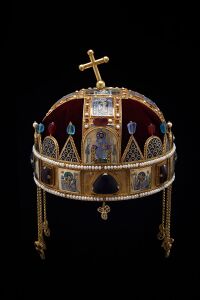United Soviet Socialist Republics of Konzask (Elparia)
United Soviet Socialist Republics of Konzask Обединени съветски социалистически републики Конзаск | |
|---|---|
| Motto: ""Пролетарии по света, обединявайте се!"
(Proletarians of the World, Unite!)" | |
| Anthem: ¡Together, Brothers! | |
| Capital | Safingrad |
| Official languages | Konzaskan |
| Recognised national languages | Konzaskan |
| Recognised regional languages | Konzaskan, Aesidian, Aytuan, Tarazian |
| Religion |
|
| Demonym(s) | Konzaskan |
| Government | Federal Parliamentary Republic |
• President | Velika Filipova |
• Second Secretary | Anton Krasimirov |
| Legislature | Parliament |
| Politburo | |
| Council of Ministers | |
| Foundational History | |
• First Thracian Kingdoms | Crica 15,000 - 500 BCE |
• Foundation of "Great Old Konzask" | Circa 300 AD 632 AD |
• First Konzaskan Empire | Circa 681 - 1018 AD |
• Second Konzaskan Empire | Circa 1185 - 1396 |
• Third Konzaskan Empire | Circa 1400 - February 1st, 1944 |
• United Soviet Socialist Republics of Konzask | February 1st, 1944 - Present Day |
| Population | |
• 2024 estimate | 143, 690, 000 (9th) |
| GDP (PPP) | estimate |
• Total | 04.727 Trillion |
| GDP (nominal) | 2024 estimate |
• Total | $4.727 Trillion (7th) |
• Per capita | $32,897 (24th) |
| HDI (2024) | .870 very high |
| Currency | Konzaskan Lev (лв) (KS) |
| Time zone | UTC+5 to +8 (Safingrad-Corlu-Standard Time\SCMT, Konzask Central Selaria Time\KCSST, Ob'Tel'Sedar Time\OTST) |
| Date format | dd/mm/yy |
| Driving side | left |
| Calling code | +359 |
| Internet TLD | .kk |
The United Soviet Socialist Republics of Konzask (USSRK; Konzaskan: Обединени съветски социалистически републики от Конзаск (ОCCPK) Obedineni sŭvet·ski sotsialisticheski republiki ot Konzask (OSSRK)) is the official name of Konzask. Konzask is a Savinist Penchevist, Federal, Parliamentary Democracy, and has been since 1944, ruled by the Konzaskan Communist Party (KCP). The Konzaskan resistance movement during the Lorraine War deposed the Third Konzaskan Empire's administration in the Konzaskan coup d'état of 1944 which ended the country's alliance with Corusconia and led to the foundation of modern Konzask.
The USSRK modelled its policies after that of Savinist Penchevism ideology, transforming the country over the course of decades from an agrarian peasant society into a heavily industrialized, socialist society. In the mid-1950s and after the death of Mladenov Penchev (the first leader of the USSRK), The USSRK further plunged itself into industrialization, becoming a notable military power, even completing their own successful nuclear project in 1956. Varying degrees of conservative or liberal influence followed,. After new energy and transportation infrastructure was constructed, by 1960 the tech industry became the dominant sector of the economy and Konzask became a major exporter of household goods and later on computer technologies, earning it the nickname of "Silicon Valley of the East". The country's relatively high productivity levels and high scores on social development rankings made it a model for other socialist countries' administrative policies.
Now Konzask is a dominant, communist major power, with a functioning nuclear arsenal, strong industry, great infrastructure and much more. Citizen support of the current "Filipova" Administration, and extent the Communist Party is at it's highest since the 1950's. Konzaskan citizens benefit from free healthcare and education, as well as extensive welfare programs, with the current administration only growing stronger after a string of multiple foreign policy victories in the growing Cold War.
Etymology
The name Konzask is derived from the Konzars, a tribe of eastern origin that founded the country. Their name is not completely understood and is difficult to trace back earlier than the 4th century AD, but it is possibly derived from the eastern word Konģhar ("to mix", "shake", "stir") and its derivative Konlak ("revolt", "disorder"). The meaning may be further extended to "rebel", "incite" or "produce a state of disorder", and so, in the derivative, the "disturbers". Ethnic groups in the inner regions with phonologically similar names were frequently described in similar terms: during the 4th century, the Koluoji, a component of the "Five Barbarian" groups in Ancient Konzask, were portrayed as both a "mixed race" and "troublemakers".
History
Prehistory
Neanderthal remains dating to around 150,000 years ago, or the Middle Paleolithic, are some of the earliest traces of human activity in the lands of modern Konzask. Remains from Homo sapiens found there are dated ca. 47,000 years BP. This result represents the earliest arrival of modern humans in Konzask. The Karanovo culture arose circa 6,500 BC and was one of several Neolithic societies in the region that thrived on agriculture. The Copper Age Varin culture (fifth millennium BC) is credited with inventing gold metallurgy in Osho. The associated Varin Necropolis treasure contains some of the oldest golden jewelry in the world with an approximate age of over 6,000 years. The treasure has been valuable for understanding social hierarchy and stratification in the earliest Kronzask societies.
The Thracians, one of the three primary ancestral groups of modern Konzankans, appeared on the Konkzanksan Peninsula some time before the 12th century BC. The Thracians excelled in metallurgy, but remained tribal and stateless. The ancient Konzar tribes conquered most of present-day Konzask in the 6th century BC and retained control over the region until 479 BC. The invasion became a catalyst for Thracian unity, and the bulk of their tribes united under King Teres to form the Safin Kingdom in the 470s BC, the namesake of Konzask's capital city, Safingrad. It was weakened and vassalized by Stephen II in 341 BC, attacked by tribes in the 3rd century, and finally became enveloped by the Konzar tribes in AD 45.
By the end of the 1st century AD, Konzar governance was established over all of modern Konzask, and surrounding nations and Christianity began spreading in the region around the 4th century. The Gothic Bible—the first Konzaskan language book—was created by Gothic bishop Theodris in what is today northern Konzask around 381. The region started to centralize into a recognizable state after the fall of the early Konzar Khans in 476. This enabled the Slavs to further interbreed with the local Thracian population, primarily through an area between the Bozhure River and the Konzask Mountains known as Mosia. Gradually, much of the coast interior of modern Konzask became a country of Southern Slavs, as Konzar and Thracian cultures and language merged over time, unified under decentralized tribal confederacy, commonly referred to as "Great Old Konzask", under a Khaganate.
First Konzaskan Empire
Not long after the Slavic incursion, Mosia was once again ignited by warfare, this time by civil war, as the Khans each began to centralize power amongst themselves. After a brief period of conflict, "Great Old Konzask" was united under Khan Ermanaric. Their specific horde originated from the territories of the old Safin Kingdom, north of the Ladoga Sea in what is now Valpovar. Ermanaric would soon expand outwards, invading territories that now encompasses modern Novavostok, Gori, Aytua, Taraz, Bursa, Aralia and Bamhkash in 680. A peace treaty with Novavostok was signed in 681, marking the foundation of the First Konzask Empire.
Succeeding rulers strengthened the Konzask state throughout the 8th and 9th centuries. Tsar Krella introduced a written code of law and checked a major Eastern incursion at the Battle of Grova, in which the Novavostok King was killed. Naso I abolished paganism in favor of Eastern Orthodox Christianity in 864. The conversion was followed by an Novavostok recognition of the Konzaskan church and the creation of the Cyrillic alphabet, developed in the then capital, Pishtip. The common language, religion and script strengthened central authority and gradually fused the Thracians and Konzars into a unified people speaking a single Slavic language. A golden age began during the 34-year rule of Emil the Great, who oversaw the largest territorial expansion of the state. Emils rule was instrumental in ensuring the longevity of the Konzaskan state.
After Emil's death, Konzask was weakened by wars with Magyars and Pecheia tribal regions and the spread of the Bogomil heresy. Pishtip was seized by the Novavostok in 971 after consecutive invasions. The Empire briefly recovered from the attacks under Sasho, but this ended when Novavostok defeated the Konzaskan army at Giodoara in 1014. Sasho died shortly after the battle, and by 1018 the Empire would collapse into succession crisis, the realm fragmenting into multiple successor states.
Second Konzaskan Empire
The ensuing succession wars would engulf the realm of the First Konzaskan Empire, and would equally lead to the foundations for many modern states, such as Bamkhash, Bursa, as well as the Gori Merchant families, who would subsequently form the Gori Merchant Republic in 1397 . In 1185 however, Tinchev dynasty nobles Ivan Tinchev I and Sreten IV organized a major uprising and succeeded in re-establishing the Konzaskan state. Ivan Tinchev and Sreten laid the foundations of the Second Konzask Empire with its capital at Tarnovin.
Nedyalko, the third of the Tinchev monarchs, extended his dominion to Belzod and Ohrin. He acknowledged the spiritual supremacy of the pope and received a royal crown from a papal legate. The empire reached its zenith under Ivan Tinchev II (1218–1241), when its borders expanded as far as the coast of Alsnia (now eastern Konzask), Servika (Now central Konzask) and Anbor (now south Konzask), while commerce and culture flourished. Ivan Tinchev's rule was also marked by a shift away from Imperial in religious matters. It would be under the Tinchev dynasty that saw the beginning of the long standing, ongoing rivalry between the Minachian Empire and the Konzask. While already bitter towards one another, Ivan Tinchev's heir would ultimately light the first sparks of the conflict after the Minachian Empire subdued the ancient Kefelarian Empire, where Emperor Tiberius of Minachia would be forced to parlay with the Konzaskan Empire, with the two states now sharing a land border. While evidence suggests both Empires sought future plans to conquer the other, for one reason or another, both Konzaskan and Minachian Empires believed there were more immedeate, pressing issues, as they mutually regarded their natural border along the center of the Isthmus connecting the continents of Osho and Remus. This single recognition would go onto define politics between the two Empires, states coveting the others territory, neither willing to risk all out war for potential very little gain.
The Tinchev dynasty became extinct in 1257. Internal conflicts and incessant Novavostok and Sijrn attacks followed. In 1277, swineherd Ivaylo led a great peasant revolt that expelled the Novavostok from Konzask and briefly made him emperor. He was overthrown in 1280 by the feudal landlords, whose factional conflicts caused the Second Konzaskan Empire to disintegrate into small feudal dominions by the 14th century. These fragmented rump states—two tsardoms at Vidin and Tarnovin and the Despotate of Sonzevac each claimed rightful claim over the Empire, with various other states gaining independence, and seeking to forge a path separate from Konzaskan identity.
Third Konzaskan Empire
Konzaskan Dark Age
After four years of conflict over competing successor states, the Despotate of Sonzevac would officially proclaim the "Third Konzaskan Empire" during the edict of Plevena, where Despot Vladislav Ivailov would be coronated as Tsar in 1400 AD. However, due to decades of extensive conflict, many records were lost during the 14th century, making it one of the least documented points in Konzaskan history. While accurate information on the wider Elparian "Dark Ages" is limited, Konzask's is in particular, lending credence to the theory of the sheer brutality of the warring rival successor states at the time. However, family trees from the ruling Ivailov Dynasty from the foundation of the Third Konzaskan Empire, and improved record keeping since it's foundation indicate that the Empire was founded sometime within March of 1400. With what little is known between 1277 AD, and 1400 AD, the Despotates of Vidin and Tarnovin had progressively expanded their territories across modern Konzask, each in an attempt to reclaim the mantle of the Second Empire, with the blood feud between the Kingdoms coming to a head in the later 1300's, engulfing much of modern Konzask in a war that left many of it's regions devastated, and much of the previously, well documented Konzaskan records either gutted, or completely destroyed. Konzasks characteristic, rigorous record keeping practice wouldn't return until the mid 15th Century, well after the solidification of the Ivailov Dynasty, with Dynastic family trees being the only accurate source of information archeologists have uncovered to solidify the exact foundation of the Third Empire.
Early Conquests of the Third Empire
The Rule of the Third Empire, and Ivailov Dynasty brought peace to the war torn Konzask, as well as paved the rise of Absolutism within the once fractured nation, as similarly observed within Remus. After nearly a century of constant conflict, much of the feudal lords and aristocracy had been either greatly diminished, if not completely eradicated, leaving both a significant administrative gap, but also providing the Tsar with a new excessive of direct authority over the realm. The power vacuum was filled by the Tsar directly taking control of administrative and political responsibilities, while filling others by new positions that required the direct appointment of the Tsar themselves, granting the Konzaskan monarchy a level of control that yet had to be seen.
With the void left by the reformation of the Empire leading to rapid centralization, the recently re founded Konzask had an army shaped by centuries of civil war, now with no enemy to be directed towards. Centuries of war, and the subsuming of defeated Despotate and Tsardoms during the Konzaskan Dark Age ensured that in the Empire's early years, it had an army of veterans, and a Monarchy eager to reclaim lost territories, and establish itself once more as a direct rival to the comparatively more stable Minachian Empire. These factors are believed to have motivated the early heads of the Ivailov Dynasty in the reconquest of territories once held by the Second Konzaskan Empire, outside the Konzaskan core regions. The Third Konzaskan Empire would strike first in 1423 in it's conquest of the Gori Merchant Republic to the South, with the goal of seizing the countries expansive ports and drydocks, to serve as the base to create a Konzaskan navy, as the contemporary Minachian Empire began taking to the seas off continent. The Third Empires early conquests would conclude with the Konzaskan expansion into North Central Osho, within modern day Aytuah and Taraz. At the time, the region was dominated by nomadic tribes, and regional Khanates with often fluid borders, as regional powers consistently rose and fall, and more often traded hands between Konzask, Novavostok and Sijran in previous centuries. Tsar Vladislav Ivailov's conquests in North Central Osho would put an end to this trend, establishing firm military rule to the region, coupled with the eventual conquest of Novavostok in later years, and decline of Sijran eradicating Konzask's regional rivals, leaving the territories of modern Aytua and Taraz under Konzaskan direct rule until the Konzaskan revolution in 1944.
The recently conquered regions, unlike within the Konzaskan core, held vastly different cultures and languages to the wider Empire, leading to the creation of regional, autonomous administration, lead by local leaders appointed by the Konzaskan Monarchy, with the regions being titled as "Grand Principalities" (eg The Grand Principality of Gori), allowing for the practice of local culture, and language, as well as limited taxation dictated by local authorities, contributing to the preservation of local cultures into the modern era, as well as preventing ethnic rebellion in the future age of enlightenment in the 18th century.
Invasion of Novavostok
The first major conquest that would go on to establish both the identity, and longevity of the Third Konzaskan Empire was it's invasion, and subsequent conquest of the Em





